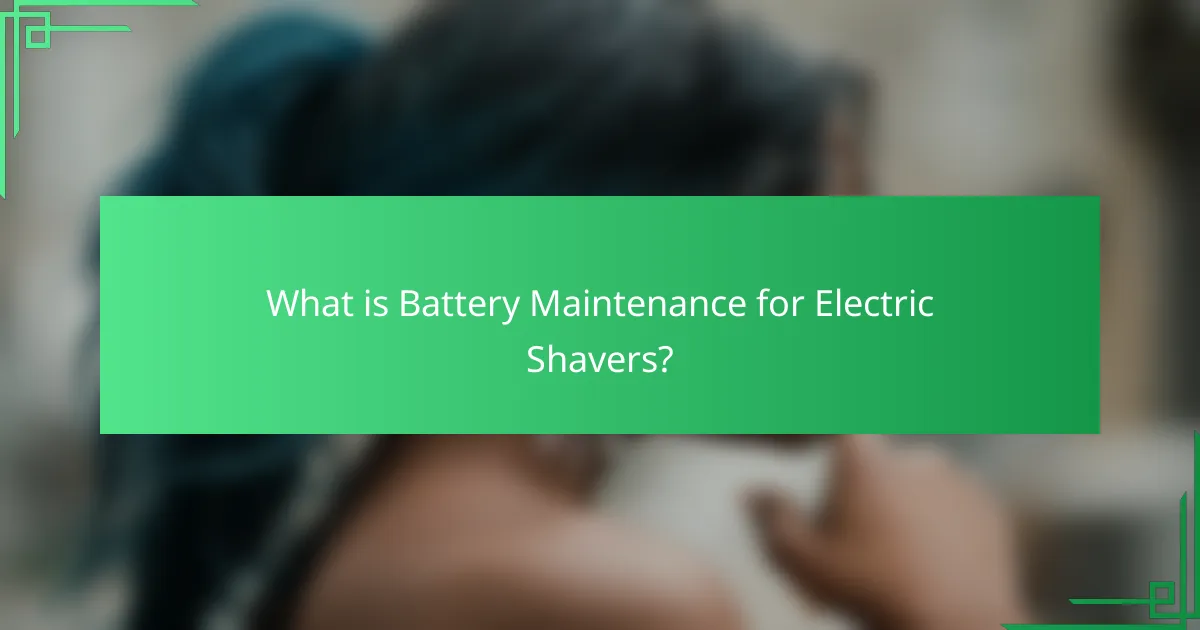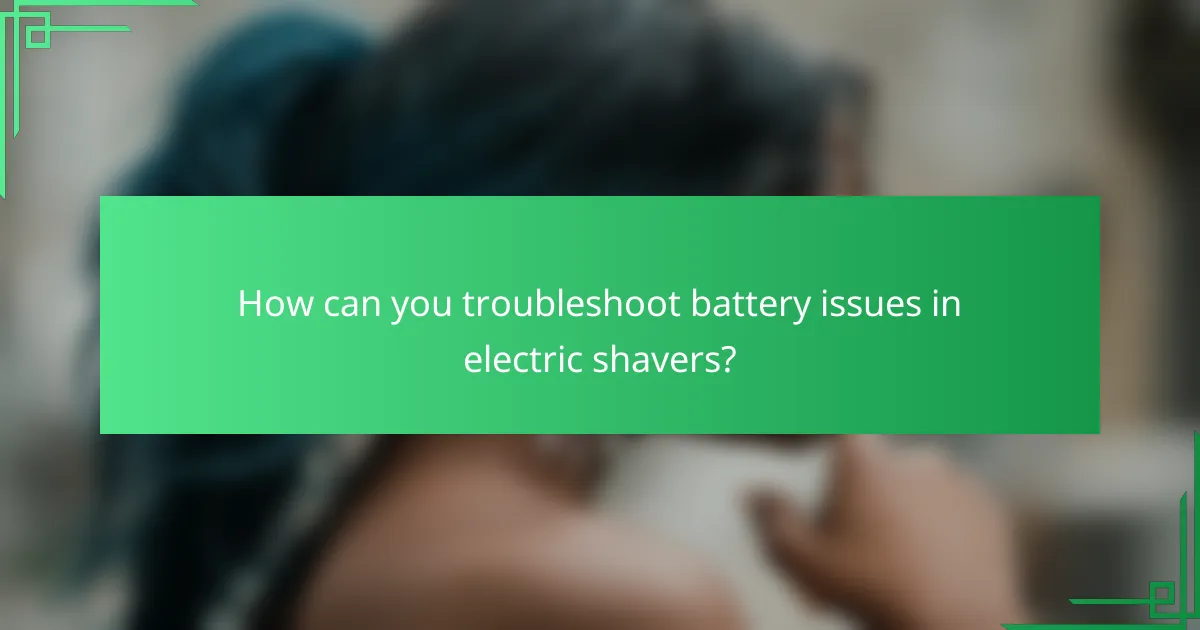Battery maintenance for electric shavers is crucial for ensuring optimal performance and longevity of the device’s battery. Key practices include following manufacturer guidelines for charging, preventing overcharging and deep discharging, and maintaining cleanliness to avoid debris buildup. Proper storage in a cool, dry place further supports battery health. The article also covers troubleshooting steps for battery issues, such as checking charging cables and inspecting the battery compartment for corrosion. Additionally, it provides tips for enhancing battery performance, including regular cleaning, consistent usage, and timely battery replacement when necessary.

What is Battery Maintenance for Electric Shavers?
Battery maintenance for electric shavers involves practices that ensure optimal performance and longevity of the device’s battery. This includes regularly charging the battery according to manufacturer guidelines. Overcharging can damage the battery, while deep discharging can reduce its lifespan.
Users should clean the shaver to prevent debris buildup, which can affect battery efficiency. Storing the shaver in a cool, dry place also helps maintain battery health. Following these practices can enhance the overall durability of the electric shaver’s battery.
Why is battery maintenance important for electric shavers?
Battery maintenance is important for electric shavers to ensure optimal performance and longevity. Proper maintenance prevents battery degradation over time. This includes regular charging and avoiding complete depletion of the battery. Lithium-ion batteries, commonly used in electric shavers, can lose capacity if not maintained correctly. Research indicates that neglecting battery care can reduce a battery’s lifespan by up to 30%. Additionally, maintaining the battery helps the shaver provide consistent power during use. Regular maintenance also minimizes the risk of overheating, which can damage internal components. Overall, effective battery maintenance leads to better efficiency and reliability of electric shavers.
What are the common battery types used in electric shavers?
Common battery types used in electric shavers include nickel-cadmium (NiCd), nickel-metal hydride (NiMH), and lithium-ion (Li-ion). NiCd batteries are known for their durability and ability to withstand numerous charge cycles. NiMH batteries offer higher capacity and are less toxic than NiCd. Li-ion batteries are popular due to their lightweight design and longer lifespan. Each battery type has distinct charging needs and performance characteristics. For example, Li-ion batteries typically charge faster and hold their charge longer compared to NiCd and NiMH batteries.
How does battery maintenance impact the lifespan of electric shavers?
Battery maintenance significantly impacts the lifespan of electric shavers. Proper care prevents battery degradation and maintains optimal performance. Regularly charging the battery ensures it does not fully discharge, which can shorten its life. Avoiding overcharging is equally important, as excessive charging can lead to overheating. Storing the shaver in a cool, dry place helps prevent temperature-related damage to the battery. Additionally, cleaning the shaver regularly can prevent dirt buildup that might affect battery efficiency. Following these maintenance practices can extend the battery life of electric shavers by several years.
What are the key components of electric shaver batteries?
Electric shaver batteries typically consist of lithium-ion or nickel-metal hydride cells. These cells provide the necessary power for the shaver’s motor. Lithium-ion batteries are favored for their high energy density and longer lifespan. Nickel-metal hydride batteries are often less expensive but have a shorter lifespan.
Additionally, electric shaver batteries include a protective circuit board. This board regulates voltage and prevents overcharging. Some batteries also feature a built-in thermal fuse for safety. These components work together to ensure optimal performance and longevity of the electric shaver.
How does the battery capacity affect performance?
Battery capacity directly affects the performance of electric shavers. Higher capacity batteries provide longer usage time between charges. This means users can achieve more shaves without interruption. For example, a battery with 2000 mAh can last significantly longer than one with 1000 mAh. Additionally, higher capacity batteries can support more powerful motors. This results in better cutting efficiency and quicker shaving. Performance consistency is also enhanced with larger capacity batteries. Users experience fewer drops in power during operation. Thus, battery capacity is crucial for optimal electric shaver performance.
What role does the charging mechanism play in battery health?
The charging mechanism significantly influences battery health. Proper charging techniques can enhance battery lifespan and performance. Overcharging can lead to heat buildup, which deteriorates battery materials. Conversely, undercharging may result in incomplete cycles, reducing capacity. Advanced charging systems manage voltage and current to optimize charging efficiency. Studies show that maintaining a charge between 20% and 80% prolongs battery life. Regularly using the correct charger also prevents damage. Therefore, the charging mechanism is crucial for maintaining optimal battery health.
What are the best practices for maintaining electric shaver batteries?
To maintain electric shaver batteries effectively, follow these best practices. First, charge the battery fully before first use. This helps calibrate the battery for optimal performance. Second, avoid overcharging the battery. Continuous charging can lead to reduced battery lifespan. Third, store the shaver in a cool, dry place. High temperatures can negatively impact battery health. Fourth, clean the shaver regularly. Dirt and hair can affect battery efficiency and performance. Fifth, use the shaver regularly. Infrequent use can lead to battery degradation. Lastly, replace the battery as needed. Most rechargeable batteries have a lifespan of 2 to 3 years. Following these practices can enhance battery longevity and performance.
How often should you charge your electric shaver?
You should charge your electric shaver after every use. This ensures optimal battery performance and longevity. Most electric shavers are designed to last up to 60 minutes on a full charge. Regular charging helps maintain the battery’s health over time. If the shaver is not used frequently, charge it at least once a month. This prevents the battery from completely draining. A fully drained battery can lead to reduced performance and lifespan. Following these guidelines will keep your electric shaver functioning effectively.
What storage conditions are optimal for electric shaver batteries?
Electric shaver batteries should be stored in a cool, dry place. Ideal temperatures range from 20°C to 25°C (68°F to 77°F). Avoid extreme temperatures, both high and low. High temperatures can degrade battery life, while low temperatures can reduce performance. Keep batteries away from moisture to prevent corrosion. Store batteries in their original packaging or a protective case. Regularly check battery charge levels and recharge if necessary. These practices help maintain battery health and longevity.

How can you troubleshoot battery issues in electric shavers?
To troubleshoot battery issues in electric shavers, first check the charging cable and adapter for damage. Ensure they are properly connected to the power source. Next, inspect the battery compartment for corrosion or dirt. Clean any debris that may obstruct the connection. If the shaver does not charge, try using a different outlet. This can help determine if the issue is with the outlet or the shaver itself. Additionally, consider replacing the battery if it is old or has been used extensively. Many electric shavers have a lifespan of 2-3 years for batteries. If problems persist, consult the manufacturer’s guidelines or customer service for further assistance.
What are the common signs of battery problems in electric shavers?
Common signs of battery problems in electric shavers include reduced runtime and inconsistent power delivery. Users may notice that the shaver does not hold a charge as long as it used to. Additionally, the device may take longer to charge or fail to charge completely. Another sign is the shaver performing poorly, such as struggling to cut hair or slowing down during use. Users might also observe that the battery indicator light behaves erratically, such as flickering or not displaying correctly. These symptoms indicate potential battery deterioration, which can affect overall performance. Regular maintenance and prompt replacement can help avoid these issues.
How can you identify if the battery needs replacement?
A battery needs replacement if it no longer holds a charge effectively. Signs include reduced runtime, frequent charging, and the device shutting off unexpectedly. Additionally, physical damage or swelling of the battery indicates a need for replacement. Testing the battery with a multimeter can reveal voltage discrepancies. If the voltage is significantly lower than the rated value, replacement is necessary. Most electric shaver batteries have a lifespan of 2-3 years, depending on usage. Regularly monitoring these factors can help ensure optimal performance.
What steps can you take to resolve charging issues?
To resolve charging issues with electric shavers, start by inspecting the power source. Ensure the outlet is functional by testing it with another device. Next, examine the charging cable for any visible damage. A frayed or broken cable can prevent proper charging. Check the shaver’s charging port for debris or corrosion. Clean it gently with a dry cloth if necessary. Consider replacing the battery if the shaver is old and holds a charge poorly. Finally, consult the user manual for specific troubleshooting steps related to your model. These steps can effectively address common charging problems in electric shavers.
What tools or accessories can assist in battery maintenance?
Tools and accessories that assist in battery maintenance include battery testers, multimeters, and cleaning kits. Battery testers evaluate the charge level and overall health of the battery. Multimeters measure voltage and can diagnose potential issues. Cleaning kits often include brushes and cleaning solutions to remove corrosion and debris. Regular use of these tools can prolong battery life. Proper maintenance ensures electric shavers operate efficiently and safely.
What types of chargers are compatible with electric shaver batteries?
Electric shaver batteries are typically compatible with two types of chargers: dedicated chargers and universal chargers. Dedicated chargers are specifically designed for particular electric shaver models. They ensure optimal charging without damaging the battery. Universal chargers can adapt to various battery types and sizes, making them versatile. However, users should verify compatibility with their specific shaver model. Many electric shavers use lithium-ion or nickel-metal hydride batteries, which require specific charging voltages. Using the wrong charger can lead to battery damage or reduced lifespan. Always check the manufacturer’s guidelines for the correct charger type.
How can maintenance kits enhance battery longevity?
Maintenance kits can enhance battery longevity by providing essential tools and products for proper care. These kits typically include cleaning solutions, lubricants, and protective covers. Regular cleaning prevents dirt and corrosion from affecting battery performance. Lubricants can reduce friction in moving parts, which helps maintain efficiency. Protective covers shield batteries from environmental damage. Research shows that consistent maintenance can extend battery life by up to 30%. Therefore, using maintenance kits effectively supports optimal battery function.

What tips can help enhance battery performance in electric shavers?
To enhance battery performance in electric shavers, regularly clean the shaver after each use. This prevents hair and debris from interfering with the battery’s efficiency. Charge the battery fully before the first use and avoid overcharging it. Overcharging can lead to battery degradation over time. Store the shaver in a cool, dry place to prevent heat damage. High temperatures can negatively impact battery lifespan. Additionally, use the shaver consistently to keep the battery active. Infrequent use can lead to battery depletion. Finally, consider replacing the battery when its performance noticeably declines. A new battery can restore optimal functionality.
How can regular maintenance routines improve battery life?
Regular maintenance routines can significantly improve battery life by ensuring optimal performance and health. These routines include cleaning the battery contacts and terminals to prevent corrosion. Corrosion can lead to poor electrical connections and reduced efficiency. Additionally, regularly calibrating the battery helps maintain accurate charge levels. This calibration process can prevent overcharging and deep discharging, both of which can shorten battery lifespan. Furthermore, keeping the battery at appropriate temperatures helps avoid damage from extreme heat or cold. Research shows that maintaining batteries within their optimal temperature range can extend their life by up to 50%. Lastly, checking for software updates can optimize battery performance by improving energy management.
What are some daily habits to adopt for better battery care?
To ensure better battery care for electric shavers, adopt the following daily habits. Charge the battery only when needed, ideally when it drops to around 20%. Avoid letting the battery drain completely, as this can shorten its lifespan. Store the shaver in a cool, dry place to prevent overheating. Clean the shaver regularly to maintain efficiency, as dirt can affect battery performance. Use the manufacturer’s charger to avoid compatibility issues. Avoid exposing the shaver to extreme temperatures, which can damage the battery. These practices help prolong battery life and maintain optimal performance.
How can you optimize the usage of your electric shaver for battery efficiency?
Charge your electric shaver fully before first use. This maximizes initial battery capacity. Avoid overcharging, as it can degrade battery life. Unplug the shaver when fully charged to prevent damage. Clean the shaver regularly to maintain performance. A clean shaver operates more efficiently, thus saving battery. Use the shaver on dry skin for optimal results. Wet skin can require more power, draining the battery faster. Store the shaver in a cool, dry place. Extreme temperatures can negatively affect battery health. Following these practices can enhance battery efficiency and longevity.
What common mistakes should you avoid when maintaining electric shaver batteries?
Common mistakes to avoid when maintaining electric shaver batteries include overcharging the battery. Overcharging can lead to reduced battery lifespan and overheating. Another mistake is letting the battery completely discharge before recharging. This can cause permanent damage to lithium-ion batteries. Additionally, neglecting to clean the shaver regularly can lead to poor battery performance. Dirt and hair can obstruct the battery’s efficiency. Storing the shaver in extreme temperatures can also harm the battery. High heat or cold can affect battery chemistry. Finally, using non-compatible chargers can damage the battery. Always use the manufacturer’s recommended charger for optimal maintenance.
How can improper charging affect battery health?
Improper charging can significantly degrade battery health. Overcharging can lead to excessive heat, which damages the battery’s internal components. Heat accelerates chemical reactions that can cause swelling and leakage. Undercharging may lead to incomplete cycles, resulting in reduced capacity over time. Frequent partial charges can create a phenomenon known as “battery memory,” limiting the usable capacity. According to studies, maintaining optimal charging practices can extend battery lifespan by up to 50%. Proper charging ensures the longevity and efficiency of electric shaver batteries.
What are the risks of neglecting battery maintenance?
Neglecting battery maintenance can lead to reduced battery life and performance. Over time, a lack of care can cause batteries to degrade faster. This degradation results in shorter usage times between charges. Additionally, neglect can lead to battery swelling or leakage. Such issues can damage the electric shaver and pose safety risks. Regular maintenance prevents these problems and ensures optimal function. Statistics show that properly maintained batteries can last up to 50% longer. Therefore, neglecting maintenance significantly impacts battery longevity and safety.
Battery maintenance for electric shavers is essential for ensuring optimal performance and longevity of the device’s battery. This article covers best practices for battery care, including charging techniques, storage conditions, and regular cleaning to prevent performance issues. It also discusses common battery types, their characteristics, and signs that indicate when a battery may need replacement. Additionally, the impact of proper maintenance on battery lifespan and performance will be outlined, along with troubleshooting tips for common battery issues. Overall, effective battery maintenance can significantly enhance the reliability and efficiency of electric shavers.